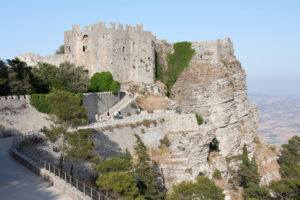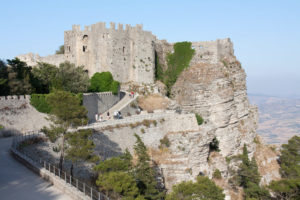Venus Castle - Erice
Taken from the site of the municipality of Erice: http://www.comune.erice.tp.it/minisitocastello/
The myth of the Venus Ericina
The origins of Erice - Iruka for the Elimi, Erech for the Carthaginians, Eryx for the Greeks and Romans - certain as an Elymian city, probably date back to the Sicans and have always been inextricably linked to the cult of the Goddess:
even before it was dedicated by the Phoenicians to Astarte, what was once the "thémenos", the sanctuary of Aphrodite, the temple of Venus Ericina, was already the place of the goddess of love. A place that would have attracted populations from all over the Mediterranean to this peak and where, according to Diodorus Siculus, Erice, son of Bute. one of Jason's argonauts, and of Aphrodite herself, had erected the temple dedicated to his mother and founded the city.
Over time, the cult of the Ericina Venus, to which passing sailors were particularly devoted thanks also to the beautiful Hierodules, young prostitutes sacred to the goddess of pleasure, grew together with her fame and wealth: Thucydides refers to " the gifts made to the Goddess, amphorae, bowls and rich household goods… ”by pilgrims and Diodorus Siculus attributes to Daedalus, who fled from Crete, the creation of a golden ram dedicated to Aphrodite. In any case, it is clear that a place like Erice, in a geographically privileged position for its very wide view, moreover fortified and effectively protected, should have assumed the power that the interest of the successive peoples attributed to the sanctuary-fortress.
Among these the Romans, who, having defeated the Carthaginians, "appropriated" the place and the cult of Venus, which had long been widespread in many Mediterranean cities, rebuilt the temple on the ruins left by the war, bringing Erice back to its ancient splendor, and built a Rome, first, a small temple on the Capitoline Hill and, in 181 BC, a larger one at Porta Collina, dedicated to the Erice goddess. The consideration of the Empire for Erice was such as to establish to place a garrison of soldiers to protect the Erice thémenos and that the most faithful cities of Sicily should also support the cult economically. Indeed, the city and its territory will be mentioned by Virgil who writes of how Aeneas stopped in these places and wanted to bury his father, Anchises, near the sanctuary, before sailing to Lazio where he founded Rome: this myth therefore linked to "Kinship" Elymians and Romans, both descendants of Venus, mother of both Aeneas and Erice ...
To her, contributing to enriching the treasury of the temple, governors, magistrates, senior soldiers offered gifts until, with the decrease in maritime traffic and with them the economic solidity of Sicily, the cult, already impoverished by the fact of being practiced in what it was having become a military center, it was eradicated by the advance of Catholicism.
After the Roman period, that of the maximum splendor, Erice was succeeded by Byzantines, Saracens - with the latter he was called Gebel al Hamid - and Normans: Ruggero d'Altavilla baptized the village and the territory Monte San Giuliano, in honor of the saint who was intervened, on horseback and with a pack of dogs, to give a hand to his soldiers against the Arabs. Who regretfully left the fortress and, above all, the women of Venus: "May Allah the Merciful make them slaves of the Muslims" wrote Ibn Giubayr in 1185.
The Norman Castle
On the remains of the sanctuary, the Normans built their castle, the fulcrum of a defensive system that included the Balio towers - from "Bajulo", as the magistrate who represented the king was called and who resided with his court in the castle - they constitute the advanced fortifications. The castle, built on the cliff of the thémenos in the XNUMXth century, was connected to the lower floor of the towers by a drawbridge, which was then replaced by the steps that are still covered today to reach it. Inside, architectural elements have been found - and, unfortunately, also lost - supporting the historical path, essentially referable to the medieval reconstruction of the fortress, in which fragments of the ancient sanctuary had also been reused, and to the rebuilding of the temple in that period. Roman.
The garden and the Balio towers
After the definitive decline from the role of fortress of the castle, only ruins of the ancient Norman towers remained and the esplanade on which the Carthaginians had erected the first fortifications was abandoned to neglect. At the end of the nineteenth century, Count Agostino Pepoli concluded an agreement with the city administration according to which he would have reclaimed the entire area at his own expense and rebuilt the towers, which would remain his property. Results of the resourcefulness of the rich and cultured patron were, therefore, the rebuilding of the pentagonal tower, destroyed in the XNUMXth century, and of the crenellated curtain to protect the internal area, as well as the construction of the Balio's “English” public garden. The latter, together with the turret that Pepoli had built on the north-west slope of the castle cliff, - today, after years of neglect, awaiting restoration and destined for the new functionality of "Observatory for Peace" - is unquestionably, one of the symbols of Erice.




